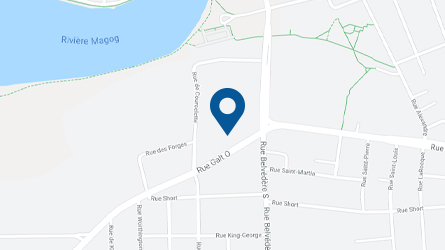Ville de Sherbrooke
- Population services
- Services to businesses
- Culture, sports and recreation
- Municipal life Visiting Sherbrooke

- Environment
- Borough offices
- Civil protection and emergency situations
- Community
- Drinking water and wastewater
- Environment
- Good neighbours
- Grants and financial assistance
- Hydro-Sherbrooke
- Immigrating and living in Sherbrooke
- Interactive maps
- Municipal Court
- Municipal property and easements
- My resident info
- Parking
- Permits and certificates
- Road maintenance
- Sherbrooke Ombudsman
- Taxes and assessment
- Travel and mobility
- Waste collection
- home
- population services
- environment
- shorelines and waterways
- shorelines in agricultural areas
Shorelines in agricultural areas
Understanding the regulation
Cultivating land for agricultural purposes is permitted on the shorelines of watercourses provided that a vegetative buffer (also referred to as a vegetative filter strip) at least 3 metres wide is maintained:
- The buffer shall be at least 1 metre wide at the top of the slope.
- The shoreline shall be measured from the limit of the shoreline or riverbank. This line corresponds to the approximate high-water mark caused by snow melt or flooding. Signs of the most recent flooding include a line of debris left by the water or a groove on the ground.
- Planting is not required within this 3-metre strip.
- The regulation applies to the banks of streams with regular or intermittent flow, as well as rivers and lakes.
For more information:
- Constructing a buffer zone (identifying and measuring the high-water mark, selecting vegetation, etc.) (in French)
- Regulation 1200 (Chapter 14, p. 14-14) (in French)
Activities permitted in the 3-metre buffer zone
- Planting trees and shrubs
- Installing fences
- Installing crossing structures (culvert, bridge or ford crossing)1
- Installing drainage outlets1
- Performing shoreline stabilization work2
- Reconstructing or widening an existing road or path, including farm and forest roads3
- Harvesting trees:
- 50% of stems with a diameter greater than 10 centimetres at DBH,4
- preserving a minimum of 50% forest cover in private woodlots used for forestry or agricultural purposes.
1-These activities require a permit. Consult an inspector, who will refer you to the appropriate resource, depending on the nature and scope of the work to be done.
2-The authorized work shall be a maximum of 50 metres in length when phytotechnologies are used, or the lesser of 30 metres or five times the width of the watercourse when inert materials are used. Where the work is to extend or join existing stabilization structures, this condition shall apply to the total length.
3-If the road is located in a streambank or riverbank, its sole purpose shall be to cross the watercourse. It shall not run alongside the watercourse in the bank. In this specific case, authorization may be granted by the Ministère de l'Environnement, de la Lutte contre les changements climatiques, de la Faune et des Parcs (MELCCFP).
4-Abbreviation used to designate the diameter at breast height, i.e. 1.3 metres above the ground.
Activities prohibited within the 3-metre strip
- Cultivating and plowing
- Spreading fertilizers or pesticides
- Mowing
- Backfilling, digging or channelization of a waterway
- Cutting 100% of trees
Benefits of buffer zones in agricultural areas
Shoreline vegetation:
- Helps to stabilize the banks
- Filters fertilizer and pesticides from fields
- Retains sediments carried in runoff water
- Reduces water temperature by creating shade
- Captures carbon dioxide (CO2) through the presence of trees
In addition to improving water quality, the combined benefits:
- Promote biodiversity and the return of fish
- Reduce greenhouse gases
Shoreline vegetation brings the following benefits to agricultural producers:
- Reduces the loss of fertile soil, which also leads to financial loss
- Reduces the amount and recurrence of maintenance work
- Creates a suitable habitat for a number of natural allies, such as pollinating insects
- Makes field work safer by reducing the risk of overturning on slopes
- Creates a natural windbreak and water level regulator
- Beautifies the rural landscape
Source: Opération bandes riveraines
Planting to give nature a boost
A natural riparian buffer composed of grasses, shrubs and trees capitalizes on the combined effect of these types of vegetation:
- herbaceous plants provide filtration
- shrubs provide stability
- trees offer a windbreak effect while creating shade
Planting provides the opportunity to:
- create a balanced combination of vegetation
- select species suitable to your site
- prevent invasive or undesirable species from becoming established and possibly spreading to the field
NB:
- Letting nature take over may be economical, but planting will deliver faster and more satisfying results.
- Increase your plants’ chances of survival by selecting native species adapted to the shoreline.
- Select species based on sunlight, soil type, moisture requirements, etc.
- Opt for species you see growing nearby—if they are already there, that means the conditions are right for them.
Source: En milieu agricole, j’agis pour une bande riveraine en santé.
Expand the buffer zone to maximize the benefits
A riparian buffer more than 3 metres wide will provide even greater benefits. This may be a good idea for sectors dealing with:
- extensive soil loss
- areas that are difficult to cultivate due to slope, etc.
Some potentially profitable activities are permitted in the 3- to 10- metre zone.
- Growing willow trees commercially
- Growing hay or bedding crops (rather than corn)
A careful assessment of the site is required. Do not hesitate to consult a professional to identify areas where widening the buffer zone would be beneficial.
For design ideas:
Assistance and grants available:
Ministerial Initiative on Compensating Agri-Environmental Practices
Club agroenvironnemental de l’Estrie (turnkey project for widening riparian buffers, including assessment, planning, grant application and planting)
Contact information

Ville de Sherbrooke - Bureau de l'environnement
731 Galt St. West, Suite 200
Sherbrooke, Quebec J1H 1Z1


